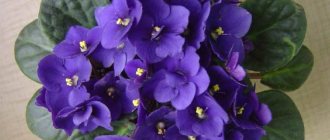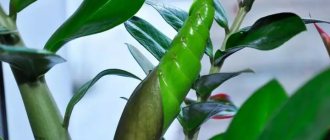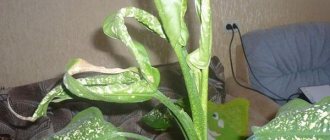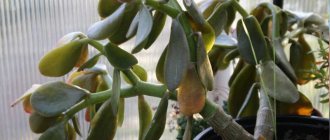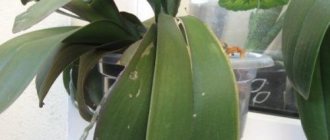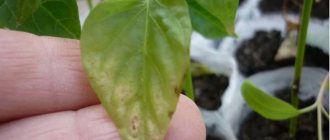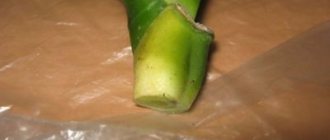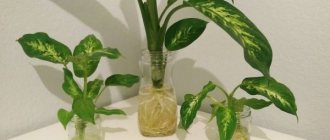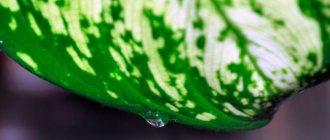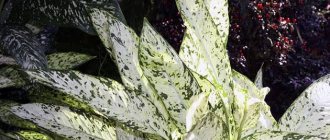Optimal conditions for the development of Dieffenbachia at home
Although Dieffenbachia is a favorite resident of the window sills of many homes and offices, it still requires a lot of attention to care. Dieffenbachia is very capricious, so those who grow it often face various difficulties. You need to choose a place for a pot with an indoor flower based on the color of the leaves. If they are monochromatic, then the plant should be placed in the back of the room, away from the light. Dieffenbachia tolerates shade well . But in this case, she will need additional lighting, especially in winter. In any case, it is necessary to avoid windows on the south side, since direct sunlight may cause the plant to die.
The correct development of a tree also depends on temperature. So for the warm season, the permissible norm in the room should be + 21 + 25. In winter and autumn, the air temperature should be from +15 to +20. There should be no drafts, wind or sudden temperature changes in the places where the flower pot is located. To water Dieffenbachia, you need to use pre-prepared water that has been infused for at least a day. In the cold season, you need to water the soil after its top layer has dried out a little. In summer and spring, watering should be regular and abundant. The soil should not dry out.
Dieffenbachia responds very well to water treatments ; for this it needs to be periodically sprayed with a spray bottle. This must be done so that excess moisture does not fall on the soil; it can be covered with polyethylene. If the plant is already large, the leaves can be wiped with a damp cloth. For the proper development of Dieffenbachia, feeding is necessary. To do this, you need to select fertilizers that do not contain lime. The procedure is carried out on average three times a month.
Common types
There is a huge variety of varieties and hybrids (their number exceeds 50), in which the leaves are differently colored with different patterns. Here are the most common varieties.
Dieffenbachia Amoena or lovely Dieffenbachia
Possible leaf length is 50 centimeters. On their surface there are stripes of green and white color, located parallel to the veins. The height of the trunk can reach about two meters. Feels great in conditions of lack of light.
Painted or variegated Dieffenbachia picta
Lovers of home flowers especially love this variety. The plant quickly grows two meters in height. It has huge oval leaves of green color, and the patterns consist of white stripes and specks. The length of the leaf is forty centimeters, and the width is 15. By planting these large and beautiful trees in the office or at home, you can feel like you are in a fabulous tropical forest.
Painted or spotted, also called Maculata Dieffenbachia maculata
Home care is most suitable for this species. The tree is stunted and grows only one meter. The length and width of the leaf is 38*11 cm. The leaf plate is elongated, pointed at the tip. The flowers bloom on a short peduncle. This variety is suitable for rooms with small dimensions. In terms of decorative features, it is absolutely not inferior to its painted companion.
The most common varieties
- Dieffenbachia Camille. The Camilla variety is planted by many gardeners. Recognized champion in height (more than two meters). The trunk is woody and stands straight. The leaves are almost white, with a green border along the edges. The middle of the leaf may be slightly greenish.
- Bush compacta Dieffenbachia maculata Compacta is a good plant to grow in small rooms; it does not take up much space. The height of the tree is only half a meter, perhaps a little higher. The leaves are decorated with beautiful large spots of white.
- Dieffenbachia Vesuvius. Vesuvius is a luxurious tree with elongated white leaves and a bright green small spotted pattern.
- Dieffenbachia Leopoldii. Dieffenbachia Leopolda. The leaves are large and the petioles are very short. The main color on the leaf blades is rich green with a white vein; there are many purple specks on the surface. In spring, Dieffenbachia produces large inflorescences (10 cm long). This variety is native to Costa Rica.
- Dieffenbachia Reflector is a flower of amazing beauty. Its coloring is unusual. The leaf blade is rounded and quite wide, pointed at the tip. In the center there is a bright strip along the vein. The main background is dark green, tinged with purple. It has yellowish-green speckles.
- Dieffenbachia Seguine Seguine. The plant is native to Brazil. The stem is strong and stable. Ovate leaf blades. The pattern consists of stripes and small specks. The inflorescence is a large ear.
- Dieffenbachia Oerstedii. The leaves look like a heart , large in size, pointed at the tip. Painted green, with a light streak in the middle. The tree loves warmth and humidity. It needs to be sprayed frequently with water from a spray bottle. It blooms in April, but it is recommended to remove the flower stalks.
- Green Magic Dieffenbachia Green Magic is a hybrid variety bred from Ørsteda. Loves light very much. It is better to place this variety on sunny windows. The large, heart-shaped leaves are dark green with a light-colored vein in the middle.
Efinbachium flowering
Perhaps some will be disappointed, but... There is no special beauty in flowers. Some varieties do not bloom at all. But the tropical shrub has very beautiful leaves.
They make you want to grow these trees. The beauty of the leaf pattern makes it possible to receive aesthetic pleasure. The large size of the crown simply cannot be ignored.
Plants refresh the room, enliven the interior, and give joy and a feeling of calm bliss.
The flowering process occurs in April and May. How does Dieffenbachia bloom? The inflorescence is an oblong spadix. The flowers are small, yellow. The cob is covered with a grey-green blanket. After some time, the blanket becomes darker. Diefenbachen blooms only when it is properly cared for.
Flowering requires a lot of energy. During this period, the plant does not grow, the leaves begin to fall. And since the leaves are more beautiful than the flowers, many amateur flower growers cut off the buds that are beginning to form. Moreover, they do this as early as possible, before the peduncle has grown too much. When flowering ends, the ears and fruits themselves do not fall. They need to be removed.
Why do Dieffenbachia leaves turn yellow and dry?
Since the exotic guest is quite capricious, her leaves often turn yellow and dry. This can be caused by both disturbances in the care process and diseases, which are quite common for this particular type of plant. Why do plant leaves turn yellow?
Violation of care rules
Several factors can lead to violation of plant care rules. In the first place is improper watering - it can be either excessively abundant or insufficient. The air in the room where Dieffenbachia is located can be very dry. This also applies to office premises, where the lighting is in most cases artificial, and the flowerpot itself is on the windowsill, where sunlight practically does not penetrate. No matter how strange it may sound, pets may also be involved in violations of plant care . They may chew or scratch the leaves of the flower, but the damage may not be noticeable at first glance. In this way, an infection can be introduced that interferes with the normal development of the plant.
Dieffenbachia diseases and methods of their treatment
Dieffenbachia, like any living creature, can get sick and be affected by infections. Fungal, bacterial and viral diseases can interfere with the normal development of the plant. Leaf spotting, which forms first at the edges of the foliage and then spreads to the entire blade, can be caused by improper room temperature or high humidity. Overwatering and accumulation of liquid in the soil can also To avoid such phenomena, it is necessary not only to reconsider the systematicity of irrigation, but also the water itself that is used for these purposes.
Anthractic disease - with a fungal disease, the stems and leaves are affected by small orange spots, which over time merge into one large lesion, leading to complete drying of the leaf. It occurs for the same reasons as regular spotting. Treatment of affected areas of the plant is carried out by spraying Dieffenbachia with fungicides.
Fusarios is an infectious flower disease that affects the roots and basal part of Dieffenbachia. Long orange spots appear on the affected areas, which lead to drying out and death of the plant. The appearance of such an infection is caused by overdried soil and lack of fertilizers. To cure a tree, you need to remove the roots from the pot, rinse it under water and get rid of the contaminated soil. Then spray the roots several times with preparations containing fungicides and transplant the plant into new soil.
How to deal with Dieffenbachia pests (video)
Root rot can also lead to yellowing and drying of leaves . To do this, as in the previous case, it is necessary to dig out the roots and clean them of infection. If the roots are black and have an unpleasant odor, this is a sure sign of disease. It can be caused by overwatering. To treat Dieffenbachia, you need to clean the infected roots, replant it in a new place, treat the soil with a fungicide and reconsider the watering.
The leaves of the plant may be subject to bacteriosis, during which watery spots with clear boundaries along the edges appear on the affected areas. The development of this disease can be triggered by infection during transplantation or cuttings. To get rid of the infection, you need to spray the plant with preparations containing copper.
Dieffenbachia pests affecting the condition of leaves
Despite the fact that Dieffenbachia is partly a toxic plant, it is also susceptible to attack by pests that damage it and affect the foliar system. The most common parasites include:
- spider mite
- aphid
- mealybug
- scale insect
The methods of control for each type of parasite are the same - it is necessary to thoroughly treat the trunk and leaves of the indoor flower with a soap solution, and then wash it off the surface of the flower with ordinary warm water. After this, you need to treat the Dieffenbachia with a specially prepared insecticide solution. If there are two or more plants in the house, it is necessary to treat the remaining home window inhabitants, since parasites tend to move from one plant to another.
Natural causes
Natural causes can also lead to yellowing of Dieffenbachia leaves. In general, this is a natural process that affects older lower leaves. However, when the first spots and dry areas appear on the leaves, there is no need to rush to get rid of them and cut them off at the root. You need to wait until the leaves are completely dry and begin to fall off. Flower growers claim that pruning leaves causes great harm to the plant.
Flea and tick repellents against scale insects.
- Dilute the contents of the pipette with drops with water; there will be no complete dissolution - an emulsion will form.
- Dilute a small pipette with 500 ml of water, and a large pipette with 1 liter of warm water.
- Then thoroughly moisten all the leaves of the plants on both sides with the resulting emulsion, try to ensure that the solution gets into the axils and covers both the stems and petioles. Be sure to wet the top layer of soil.
- Leave the solution on the plant to dry.
- Wash the window sills and glass with the same solution (or just soap).
- When the plants are dry, ventilate the room thoroughly.
- There is no need to wash off the flea and tick repellent; if the smell remains, you can wash off the emulsion the next day. One flea and tick treatment is usually sufficient. But if the damage was very strong, you need to repeat the treatment after 7 days.
Why do drops form on Dieffenbachia leaves?
It happens that drops form on the leaves of Dieffenbachia; flower growers call this “Dieffenbachia crying.” In most cases, this is a natural process in which moisture is released through special mouths - hydathodes. If the phenomenon occurs quite often, you need to reduce the amount of watering, but do it carefully to prevent the soil from drying out.
Dieffenbachia leaf propagation technology
The beauty of Dieffenbachia is that it is quite easy to propagate. An adult plant, more than two years old, is better suited for this. It is better to cut the leaf from the very top and as close to the trunk as possible , leaving a few buds on it. To avoid excessive sap production, reduce watering a few days before pruning. It is better to trim the cuttings with a sharp serrated blade so as not to injure the internal fibers. The cut top can be placed in water or immediately planted on ready soil.
